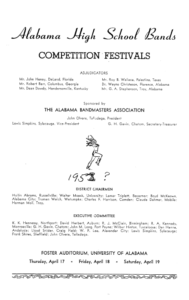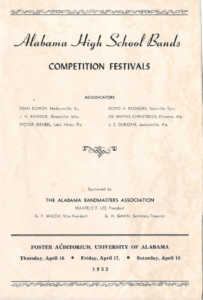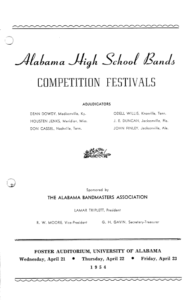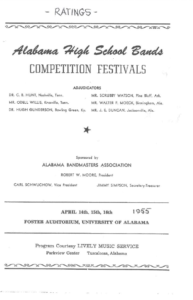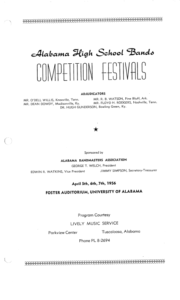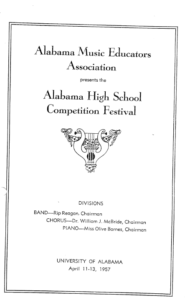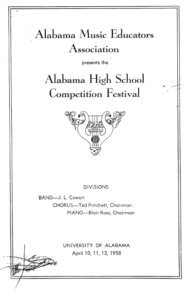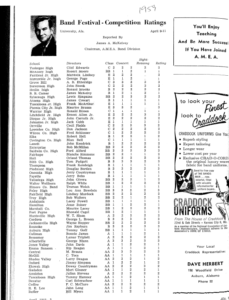1940‘s – 1950‘s – 1960‘s – 1970‘s – 1980‘s – 1990‘s – 2000‘s – 2010‘s – 2020‘s
The 1950s was a decade of expansion of the Alabama Bandmasters Association in general and this event in particular. Enjoy reading about this part of the history of Alabama’s school band movement and the members of the Phi Beta Mu Hall of Fame who helped shape it.
Click the year or the program cover to open a PDF of the printed program.
1950
Not available
1951
Not available
1952
The competition-festival, after two years in Birmingham, had returned to the University of Alabama. Quite a few members of the Phi Beta Mu Hall of Fame were represented: Bodie Hinton, Blanche Simmons, Carl Schwuchow, Dewey Countryman, John M. Long, Herman Moll, Jimmy Cowart, Lewis Simpkins, Floyd McClure, Lamar Triplett, Yale Ellis, and Mort Glosser.
The classification system was expanded with the addition of an “AA” classification. Another significant enhancement was the addition of the Solo & Ensemble festival. According to Dr. Bodie Hinton’s dissertation, 1952 marks the first year of Solo & Ensemble. Dr. Hinton writes, “In 1952, there were not enough solos and ensembles to fill an entire program for one day.”
1953
The competition-festival continued the pattern of being a three-day event. The location was Foster Auditorium, a tradition that would continue for many years. This year’s program includes ratings for the bands, handwritten by the owner of the printed programs. Where there are two scores, it is assumed the first is the score for the concert performance and the second is the sight-reading score. This year, Hall of Fame member Pasquale Bria makes an appearance.
1954
Each year, the program includes an explanation of how the final rating is determined. Each combination was spelled out:
- SUPERIOR: (1-1-1) (1-1-2) (1-1-3) (1-1-4)
- EXCELLENT: (1-2-2) (1-2-3) (1-2-4) (2-2-2) (2-2-3) (2-2-4)
- GOOD: (1-3-3) (1-3-4) (2-3-3) (2-3-4) (3-3-3) (3-3-4)
- FAIR: (1-4-4) (2-4-4) (3-4-4) (4-4-4)
Notice sight-reading is not included in the ratings. It did impact ratings in one way: “Class AA, A, and B bands may not receive a rating more than one division given them by the sight-reading adjudicator.”
This year was the first for District Competition-Festival. A band rated “Superior” at the state competition-festival automatically qualified to return to again the following year. All other bands had to first qualify at the district level.
1955
This year was the first appearance for a Hall of Fame members who impacted the Alabama Bandmasters Association and the Alabama Music Educators Association for many decades. Lacey Powell brought the Georgiana High School Band to competition-festival, scoring all “Superior” ratings. This year, three more Hall of Fame members made their debuts at the event. Orland Thomas brought his Holt High School band. Truman Welch brought his Elmore County High School band. Claude Dahmer brought his Murphy High School band.
Truman Welch approached the issue of developing a full instrumentation in a small community by combining the bands from Wetumpka and Eclectic. The combined band performed at football games for both schools as well as combining for concert band activities. Ten years later, this band would be the first Alabama band to perform at the prestigious Midwest Clinic.
In his dissertation, Dr. Hinton referred to this year’s solo and ensemble participation by saying, “In 1955, it was necessary to devote two full days to this part of the Festival.” The final page of this year’s program lists the 12 solos and four ensembles. Ten of the events were from Decatur High School under the direction of Hall of Fame member Carl Schwuchow. It is unclear whether there was a preliminary festival, and the best events advanced and appear in the program as “finals.” Another possibility is the 16 events were spread over two days.
1956
This year’s program is interesting because of the musical selections. It might appear each classification played the same required selection. Notice the frequency of “Three Bach Chorales” for Class C, “Lustspiel” for Class B, “Kentucky 1800” for Class A, and “Festival Overture in F” for Class AA. It is possible this year was the advent of the required list and the number of selections on the list was very small. A third possibility is the influence of the Alabama Bandmasters Association annual clinic. Each December, a clinic at the University of Alabama included the University of Alabama band reading through music published during the previous year. “Kentucky 1800” and “Fantasy for Band” were published in 1955. “Sea Portrait” was published in 1956.
Larry Deagon makes his debut at the competition-festival with his Shades Valley High School band.
The program shows the increased popularity of Solo & Ensemble, an event well-established as an important part of this festival. “Piano” appears as part of the festival as well.
1957
This year marked the first appearances for Hall of Fame members Tommy Goff and Jerry Bobo. Again this year, we see the popularity of a small number of works. “Storm King” (Finlayson) was a popular march. “Fantasy for Band” (Erickson), “Kentucky 1800” (Grundman), “Sea Portrait” (LaGassey), and “First Suite in Eb” (Holst) were popular.
For the first time, junior high bands received their own classification. Before this year, junior high and first-year high school bands were grouped together under “Class D.” Beginning this year, “Class E” designated junior high bands.
The number of events for the Solo & Ensemble portion of the festival increased greatly over the year before. We also see the inclusion of a choral-music festival spanning the same three days. Hall of Fame members Carl Schwuchow and Floyd McClure and listed as the directors of their school choirs.
1958
Hall of Fame member Jerry Countryman makes his debut this year with his Oneonta High School band. Hall of Fame member Frank Kendeigh makes his debut this year with his Thompson High School band.
The classification system expands once again with the introduction of “Class BB.”
The festival continues to include band, chorus, piano, and solo & ensemble.
1959
No printed program is available for this year. What we do have is a page from the AlaBreve magazine which lists the schools, directors, classifications, and ratings.
After having added “Class BB” to the classification system a year earlier, the definition of each classification is as follows:
- Class AA 900 or more students (grades 9-12)
- Class A 600-899
- Class BB 400-599
- Class B 250-399
- Class C Less than 250
- Class D Beginner bands (organized since the second semester of the previous year)
- Class E Junior high bands
